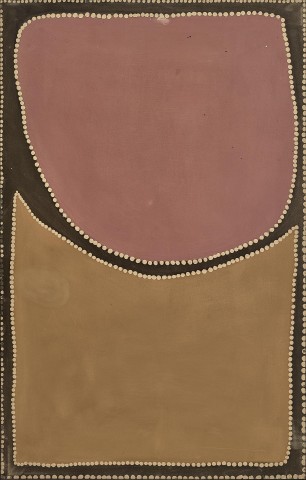BARAGU COUNTRY, 1989
ROVER THOMAS (JOOLAMA)
natural earth pigments and bush gum on canvas
110.0 x 70.0 cm
bears inscription verso: artist’s name, size, Waringarri Arts cat. S-1988 and AP1971
Waringarri Arts, Kununurra, Western Australia (label attached verso)
Deutscher Gertrude Street, Melbourne (label attached verso)
The Peter and Renate Nahum Collection of Aboriginal Art, London, acquired from the above in 1989
Turkey Creek: Recent Work: Rover Thomas/Paddy Jaminji/George Mung Mung/Jack Britten/Freddy Timms, Deutscher Gertrude Street, Melbourne, 25 October – 17 November 1989, cat. 4 (illus. exhibition catalogue front cover)
The art of Rover Thomas is synonymous with East Kimberley painting, but his origins lie further south in the Great Sandy Desert. Born at Yalta, a soak just north of Kunawarritji (Well 33) on the Canning Stock Route, after the death of his parents at the age of ten, he travelled north following stockmen along the Canning to Bililuna and beyond into the Kimberley. Rover eventually became a stockman himself and his travels across vast swathes of country infuse his later art practice.
Painted for Waringarri Arts in Kununurra in 1989, the year before Rover Thomas was selected as one of the first two Aboriginal artists (together with Trevor Nickolls), to represent Australia at the Venice Biennale, Baragu Country exemplifies the best of his paintings. Layers of natural pigments affixed with a synthetic binder are outlined by a tracery of white dots painted with huntite, a white chalky pigment used in ceremony and rock art. The canvas, lightly infused with the natural pigments, develops a unique velvety surface. The work shows an aerial view of the landscape where two large irregular forms infilled with light sandy brown and light red/dusky pink pigments are bisected and surrounded by a narrow band of black charcoal.
The subject of this painting is Lake Gregory, now known by its Walmajarri name Paruku, which is a declared Indigenous Protected Area (IPA) that covers around 430,000 hectares on the borders of the Great Sandy Desert and Tanami regions, 200 kilometres south of the township of Halls Creek in Western Australia. An area of spectacular wetlands that is internationally renowned as a haven for large numbers of birds and other animals, it includes an extensive lake system, the only one in the region with a reliable source of fresh water. Primarily sourced from Tjurabalan (Sturt Creek) which flow into Lake Gregory from its beginnings some 800 kilometres north-east across the border in the Northern Territory, it is an important site for the local indigenous people. The traditional owners believe it was formed when a star fell from the sky into the lake and transformed itself into a man, becoming the very first Traditional Owner of this place. A breeding ground for budgerigars, Lake Gregory is also the home of the Billiluna Rainbow Snake.
Rover Thomas articulated a highly personal way of telling stories and establishing connection to the land and its related ceremonies. Idiosyncratic in style, his paintings established a new typology and visual language distinct to the east Kimberley region of Western Australia. Both planar and aerial views of land are united in his compositions, where the past and the present also converge. They map tracts of country whilst exploring the regional history and ancestral tales of these same locations. Thomas’ compositions carefully balance the landscape and the narrative in natural harmony – executed in earth pigments and natural resins, his canvases are characterised by the interaction between large open expanses and bold forms.
In August 2001 the High Court of Australia formally recognised the Traditional Owners of this area held native title over the land. The handover ceremony was conducted on the shores of Paruku, symbolising the significance of this place to local Aboriginal people.
CRISPIN GUTTERIDGE
